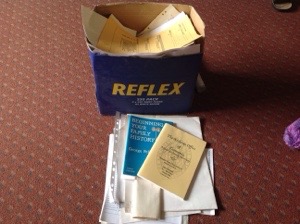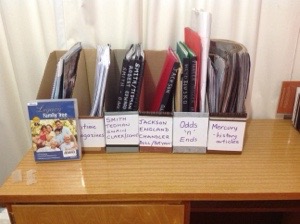I have started.
I can nearly see the floor of the office area. Lots of old, stained and faded papers have been put out to use in the mulch – these were my handwritten notes from visiting the archives back in the 70’s and 80’s. All the data that I meticulously wrote out is now online via LINC Tasmania Family History and Heritage in the Tasmanian Names Index. I am so lucky that most of my research from the early 1800’s is only in Tasmania and is either free settlers or convicts. Also lucky that our archives have now digitised all the BDM records from 1804 onwards.
I have ordered Legacy 8.0 from Gould Genealogy and that should arrive in the next week or so. I have joined the Legacy Users facebook group which has already been useful in answering my questions.
Update 1: One box sorted. Most was A4 sheets printed from my computer when I was researching Tasmanian convicts for people during the 80’s and 90’s. They would ask for help via roots web email lists or through RAOGK and I would head to the archives to check the microfilm and send replies back to them. Out of that full box, I have kept about 15 personal records and photos – the rest will go to mulch the garden.
Update 2: Office area is now clean, desk is clear to be able to use, many of those records I kept are now in folders grouped under married couple names. Legacy 8 has arrived and I have still not installed it on the computer. Filing cabinet is has been cleaned out and very little kept as most of the info is now online. Some are letters from family members who gave me data after having attended a family reunion so will keep these as personal mail – this was in the time before emails.
Update 3: All digitised documents and images are now stored in two folders on my PC. Luckily I haven’t done much scanning of documents and photos but that is for the future. Images I had scanned were labelled with SURNAMEfirstnameyear so at least I have started correctly and will only have to change a few to get a common naming pattern. If the images were from newspapers (Trove) I had included the citation info as a tag so I will have that handy when adding to Legacy database sometime this year.
Evaluation:
So part 1 of the January do over is now complete. I have set aside all my previous research and put it on hold in case it is needed in the future. This wasn’t really hard to do as despite having 40 years worth; most of it was already on my Master Genealogist database on my PC or was paper copies of what is now digitised here in Tasmania so will be easy to find when adding to my Legacy database. My office area is now so much tidier and I have found a desk under all the mess that had been there. Last step will be to mulch all the papers I have thrown away.
Part 2 of the do over is to prepare for my research. So here is my list of Golden Rules for Researching that I want to follow in future.
Golden Rules for Researching
- Spend no more than 5 hours per day researching genealogy or scanning images – remember I am retired so have plenty of time
- Only add data to Legacy database that has proof attached – include citation of sources
- When visiting archives or using internet, add information to Evernote so it syncs with home PC where Legacy will be saved.
- Create a research check list per person that can be ticked off when you have proof of that event – include citation on check list
- Once I have the basic names, dates and places of direct ancestors on the Legacy database, then research their stories for military, immigration and newspaper articles etc
My next step is to learn how to use Evernote before I add the Legacy software to my computer. I have added the web clipper to my PC at home and the Evernote app to my iPad. I have joined the Facebook page Evernote for Genealogists group and am sure I will have some questions as I start using it.
Readers: If you are following Thomas MacEntee’s Genealogy do over or go over, do you think there is anything more I need to add to this post? Reading his workbook, I wasn’t sure about his ‘warm up’ exercises?


